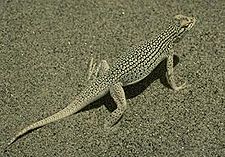Lepidosaurs facts for kids
Quick facts for kids LepidosaursTemporal range: Triassic – Recent
|
|
|---|---|
 |
|
| A Coachella Valley Fringe-toed Lizard | |
| Scientific classification | |
| Kingdom: | |
| Phylum: | |
| Class: | |
| Subclass: | |
| Infraclass: | |
| Superorder: |
Lepidosauria
|
| Orders | |
|
|
The Lepidosauria are a special group of reptiles. Their name comes from Greek words meaning scaled lizards. This is because they all have unique scales that overlap each other.
This group includes many animals you might already know, like all the different kinds of lizards and snakes. It also includes some less common reptiles, such as the tuataras and amphisbaenians. Lepidosaurs are a major part of the larger group called Sauropsida, which includes all reptiles and birds.
Contents
What Makes Lepidosaurs Special?
Lepidosaurs have several cool features that set them apart.
Overlapping Scales
One of their most noticeable features is their overlapping scales. These scales are made of keratin, the same material as your fingernails. They help protect the animal's body and prevent it from drying out.
Shedding Skin
Most lepidosaurs regularly shed their outer layer of skin. This process is called ecdysis or molting. It allows them to grow and repair their skin. Snakes often shed their skin in one piece, while lizards shed it in patches.
Flexible Jaws
Many lepidosaurs, especially snakes, have very flexible jaws. Their jawbones can move separately. This allows them to open their mouths incredibly wide to swallow prey much larger than their heads.
Special Senses
Some lepidosaurs have amazing senses. For example, many snakes have pit organs. These are special heat-sensing pits on their faces. They help the snake detect warm-blooded prey, even in complete darkness. Lizards often have excellent eyesight and can see a wide range of colors.
Types of Lepidosaurs
The Lepidosauria group is divided into two main orders:
Squamata
The Squamata order is the largest group of reptiles. It includes all lizards and snakes. This group is incredibly diverse, meaning there are many different kinds of squamates living in almost every habitat on Earth.
- Lizards: Lizards are reptiles with four legs, a tail, and usually eyelids. They come in all shapes and sizes, from tiny geckos to large monitor lizards. Some lizards, like chameleons, can even change color!
- Snakes: Snakes are unique because they don't have legs. They move by slithering their long, flexible bodies. Snakes are found all over the world, from deserts to oceans. Some snakes are harmless, while others are venomous.
Sphenodontia
The Sphenodontia order is much smaller. Today, it only includes the tuataras. Tuataras look like lizards but are actually a separate, ancient lineage of reptiles. They are often called "living fossils" because they have changed very little over millions of years.
- Tuataras: Tuataras are native to New Zealand. They have a special "third eye" on top of their head, though it's covered by skin and only sensitive to light. They are mostly active at night and can live for a very long time, sometimes over 100 years!
Where Do Lepidosaurs Live?
Lepidosaurs live in many different places around the world. You can find them in:
- Deserts: Many lizards and snakes are perfectly adapted to hot, dry desert environments.
- Forests: Tree-dwelling lizards and snakes are common in tropical and temperate forests.
- Grasslands: Open grasslands are home to many ground-dwelling species.
- Water: Some snakes and lizards are semi-aquatic or even fully aquatic, living in rivers, lakes, or oceans.
They are found on every continent except Antarctica. This wide range shows how adaptable these reptiles are to different climates and habitats.
Images for kids
-
A diagram of a squamate skull, showing its bone structure.
-
The foot of a skink, showing its overlapping scales.
-
A python (top) and a rattlesnake (bottom) showing their heat-sensing pit organs (red arrows).
-
An eastern brown snake preying on an eastern blue-tongued lizard.
-
A map showing where different lizard species live around the world.
-
Boots made from snake skin, showing the patterns of diamondback rattlesnakes.
See also
 In Spanish: Lepidosaurios para niños
In Spanish: Lepidosaurios para niños











